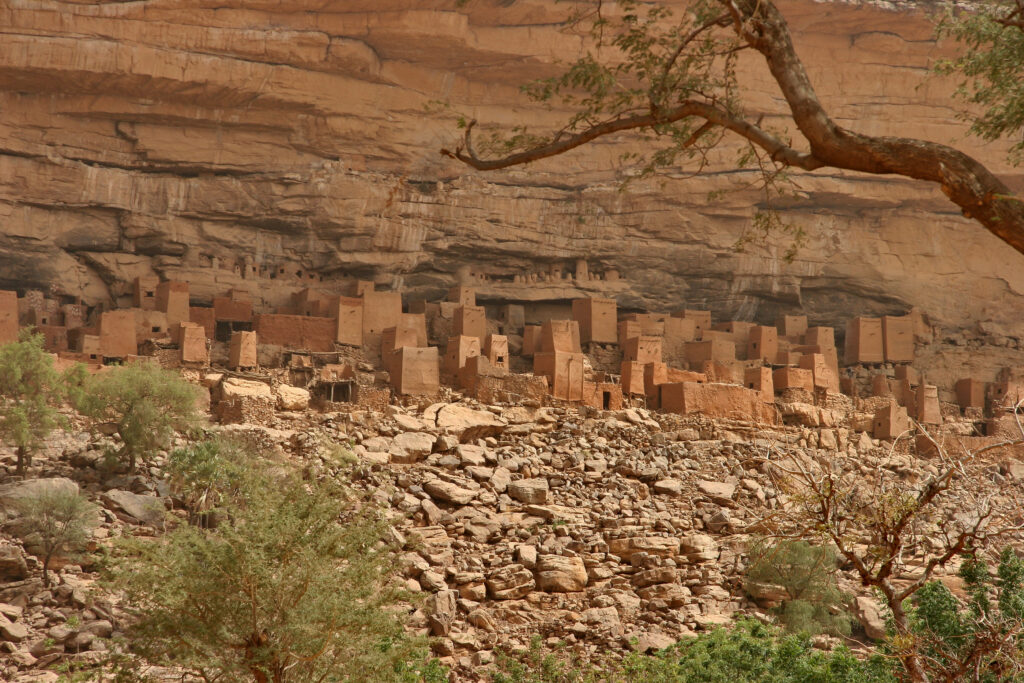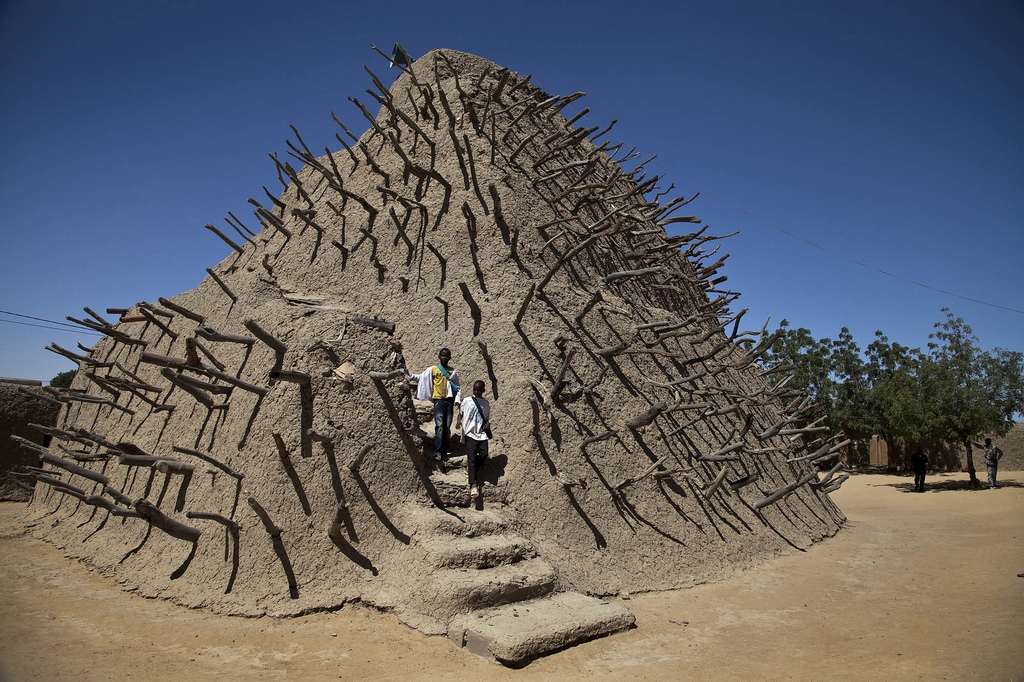Quick facts about Mali:
- Population: Approximately 24.5 million people.
- Capital: Bamako.
- Official Language: French.
- Other Languages: Bambara, Fula, and other indigenous languages.
- Currency: West African CFA franc (XOF).
- Government: Semi-presidential republic (though it has experienced political instability in recent years).
- Major Religion: Islam, with a small Christian population and traditional African beliefs.
- Geography: Located in West Africa, landlocked, bordered by Algeria to the north, Niger to the east, Burkina Faso and Côte d’Ivoire to the south, Guinea to the southwest, and Senegal and Mauritania to the west. Mali has diverse landscapes, including vast deserts in the north (part of the Sahara), savannas, and the Niger River, which is central to its economy and agriculture.
Fact 1: A substantial part of Mali is occupied by the Sahara Desert
Significant portion of Mali is covered by the Sahara Desert, especially in the northern and northeastern regions of the country. Approximately two-thirds of Mali’s land area consists of desert or semi-desert terrain. This includes vast stretches of sand dunes, rocky plateaus, and arid landscapes. The Sahara in Mali is home to the Tombouctou (Timbuktu) region, which historically served as a major cultural and trading center.
Mali’s desert regions face extreme temperatures and limited rainfall, making the land largely inhospitable. However, these areas are also rich in natural resources, including salt, phosphates, and gold, which have been important to the economy for centuries. The desert’s unique ecosystems, such as those found in the Adrar des Ifoghas mountain range, are home to various species adapted to life in harsh conditions.
Note: If you are planning an exciting trip to Mali, check if you need an International Driving Permit to rent and drive a car.

Fact 2: The territory of Mali was settled at least over 12,000 years ago
Archaeological evidence shows that the region was inhabited at least 12,000 years ago, with evidence of early human activity dating back to the Paleolithic period. One notable site is the Faynan rock art in the Niger River valley, which features paintings and engravings that provide insights into the early cultures that lived in the area.
Mali’s ancient history is also marked by the development of significant early civilizations, particularly the Niger River valley, which supported agricultural societies. By around 1000 BCE, complex societies began to emerge, leading to the establishment of powerful empires, including the Ghana Empire (not to be confused with modern-day Ghana), and later the Mali Empire, one of the most prosperous and influential empires in West African history.
Fact 3: Mali has 4 sites under UNESCO protection and many candidates
Mali is home to four UNESCO World Heritage sites, recognized for their historical, cultural, and natural significance. These sites are:
- Timbuktu (1988) – Famous for its ancient Islamic architecture, including the Djinguereber Mosque and the Sankore Madrasah, Timbuktu was a leading center of learning, culture, and trade in the 15th and 16th centuries.
- Djenné (1988) – Djenné is known for the Great Mosque of Djenné, a stunning example of Sudano-Sahelian architecture made from mud bricks. It is considered one of the largest mud structures in the world.
- The Cliff of Bandiagara (Land of the Dogons) (1989) – This site is known for its dramatic cliffs and the ancient Dogon villages perched along them. The Dogon people are famous for their traditional culture, including unique art, architecture, and religious practices.
- W Regional Park (1982) – Located in the tri-border area of Mali, Niger, and Burkina Faso, this park is a significant natural site, home to diverse wildlife, including elephants, buffalo, and lions. It is part of a transnational biosphere reserve.
Additionally, Mali has several tentative sites that are being considered for future UNESCO World Heritage status, which include places like the Cultural Landscape of the Aïr and Ténéré in the Sahara, and the Bamako and its surroundings, which have cultural and historical value.

Fact 4: At the time of colonization, Mali was called French Sudan
This was the name used by the French colonial administration from 1890 to 1960. French Sudan was part of the larger French West Africa federation, which included several other territories in West Africa such as Senegal, Mauritania, Ivory Coast, Niger, and Burkina Faso.
The name French Sudan was used to refer to the vast area that is now modern Mali, which was a key part of France’s colonial empire in Africa. The French sought to exploit the region’s resources, including its agricultural potential and gold deposits, and used forced labor and a system of taxation to maintain control.
After a series of nationalist movements and the broader wave of independence across Africa, French Sudan gained its independence on September 22, 1960, and became the Republic of Mali. The country’s first president was Modibo Keita, who had been a prominent figure in the push for independence.
Fact 5: Mali ranks among the leaders in birth rates
As of recent data, Mali has a fertility rate of approximately 5.9 children per woman, which is significantly higher than the global average. This places Mali among the top countries globally for high birth rates, with many families having large numbers of children.
Several factors contribute to this high birth rate, including traditional family structures, limited access to contraception, and cultural norms that favor larger families. The country’s youthful population—with a median age of about 16 years—also plays a role in sustaining high birth rates, as a large proportion of the population is in the childbearing age group.

Fact 6: At the moment, Mali is not a safe country to visit
The country faces ongoing security challenges, particularly in the northern and central regions, where armed groups, including Islamist militants, are active. These groups have been involved in terrorist attacks, kidnappings, and armed conflicts, contributing to instability.
Mali has also experienced political unrest and military coups in recent years. In 2021, a coup led to the ousting of the president, and the political situation remains fragile. This, combined with violence from extremist groups and intercommunal conflicts, makes travel in certain parts of the country risky.
The United Nations and several foreign governments, including the U.S. and European Union, advise against all non-essential travel to Mali, especially in regions like the north and central areas. Travelers are strongly urged to stay informed about security conditions and to follow local government guidelines if they must travel there.
Fact 7: Djenné Mosque in Mali is renovated annually
The mosque, built in the 13th century and considered the largest mud-built structure in the world, is primarily constructed from adobe (mud bricks) and requires constant upkeep due to weathering, especially during the rainy season.
Every year, the local community comes together to carry out this renovation work, using traditional techniques passed down through generations. This process is part of the Festival of the Great Mosque of Djenné, a significant event that brings together craftsmen and local builders to repair and restore the mosque.

Fact 8: Probably the richest man in history lived in Mali
Mansa Musa I, the ruler of the Mali Empire in the 14th century, is often considered the richest person in history. His wealth was so immense that it is difficult to quantify in modern terms. Mansa Musa’s fortune was largely derived from the vast natural resources of Mali, particularly its gold mines, which were among the richest in the world at the time, as well as from salt production and trade.
Mansa Musa’s wealth became legendary during his famous pilgrimage to Mecca (Hajj) in 1324. During the journey, he traveled with a large entourage of thousands of people, including soldiers, officials, and slaves, and distributed gold generously along the way, particularly in Egypt. This extravagant spending caused a temporary devaluation of gold in the regions he passed through. His lavish display of wealth and the spread of his riches across North Africa contributed to his enduring legacy.
Fact 9: The territory of Mali was also partly home to the Songhay Empire
The Songhay Empire emerged as one of the largest and most influential empires in West Africa, particularly during the 15th and 16th centuries.
The Songhay Empire rose to prominence after the decline of the Mali Empire. It initially formed as a kingdom around the city of Gao, which is located in present-day Mali, and later expanded to control a large swath of West Africa. At its height, the empire controlled important trade routes across the Sahara, dealing in commodities like gold, salt, and slaves.
One of the most notable leaders of the Songhay Empire was Askia Mohammad I, who established a centralized administration, promoted Islam, and expanded the empire to its peak in the 15th century. He also made significant efforts to develop education and trade.

Fact 10: Mali is now one of the poorest countries in the world
As of recent data, Mali’s GDP per capita is low, and the country ranks among the poorest nations on the Human Development Index (HDI). The country’s economic performance is constrained by several factors, including political instability, security issues, and a reliance on agriculture and natural resources, sectors that are vulnerable to external shocks like climate change.
According to the World Bank, around 40% of the population lives below the poverty line, and child malnutrition and lack of education are significant issues.

Published November 10, 2024 • 8m to read





